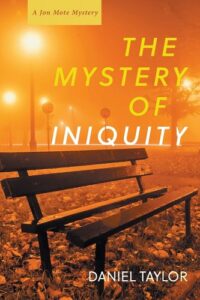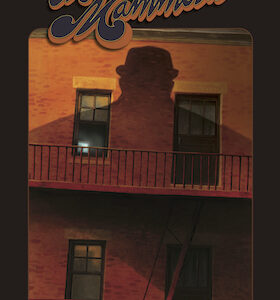I didn’t know I was a mystery writer until my editor informed me. Finding out started me thinking about the nature of mystery generally and the mystery story in particular. In time I decided I was more interested in Mystery than in mystery and that the distinction is significant both for writers and for readers.
Mystery is one of the largest categories of human experience. It is so because the human brain is so-constructed as to be obsessed with the not-yet-known. The brain always seeks to know “what comes next and what does it mean?” Meaning, in this sense, ranges from “Is there danger in that unexpected sound?” to “Is there something more to reality than what the senses can detect and measurement prove?” Which is to say, there is mystery and then there is Mystery.
In an important sense every story—hence every literary narrative—is a mystery story. Without mystery there is no plot—the “what happens next” of every story. All storytelling, from lit to history to theology to memoir to science writing, involves the sequential release of information, the more skillful of which appeals to the brain’s hunger for connections.
As I say, I did not know I was a mystery writer until my editor told me so after reading my first novel and then announcing it on the cover of my second. It’s my own fault. If you don’t want to thought a mystery writer, don’t title your novel Death Comes for the Deconstructionist and do not produce a dead body. And do not, in an allusion to Shakespeare, title the second, Do We Not Bleed?”
Actually, I’m fine with the notion that I’m a mystery writer, I simply want to insist that my novels are less interested in mystery than in Mystery, bodies or no bodies (the last one—The Mystery of Iniquity—never quite gets around to producing one, though the possibility is always in the air). Trying to sort out the difference for myself between mystery and Mystery has led me to distinguish—without any claim to ground breaking—various kinds of mystery within the broad literary category.
The first level is mystery about facts. What has happened? Who is involved? What does reasonable observation tell us? It’s the main interest for some readers.
Even at this level one must be careful. Genuine facts can mislead as well as reveal (ask anyone falsely accused). Because they must be interpreted, facts can point in the wrong direction. That’s why we distinguish between “brute facts” and “truth.” No story is just its facts. In fact (word play intended), facts do not even form a story—or a plot—until they have been arranged, interpreted, applied, and acted on—that is, until the facts have been massaged into a conclusion. Which is to say, find their place within a story. That whole process is inherently interesting to the mind (a product, most think, of the brain), and some mystery stories operate almost entirely at that level. In short, the “whodunit?”
The mystery stories we remember and return to, however, do more. The second and for most people indispensable level of mystery is “why?” For instance, “Why is this person dead?” If suicide, why? If not, who and why both? This moves us from the factual “what happened and how” to the more mysterious “why?” Which gets us to human nature, the one thing writers and readers find infinitely mysterious—and engaging.
Some argue whether plot or character is primary in mystery writing. It’s a false either-or. As the great William James observed, plot (“incident”) in storytelling is the working out of character. Plot is supplied by characters being human. These unique and yet representative characters doing these things from these motives is the plot of this unique and yet representative story. Plot is human nature expressing itself under stress.
And such is why we read and listen. Brute facts do not make a story, any more than security camera video creates a film. We are drawn to characters discovering and interacting with the facts, especially the facts about themselves. The ‘ah ha’ moments of the characters become the ‘ah ha’ moments of the reader or audience. (And sometimes the reader/audience has such a moment before the character does.)
Socrates says, “Know thyself.” The Apostle Paul finds himself a mystery (and a Mystery), unable to explain why he does what he hates. Self-improvement gurus tend to follow Socrates. Fiction writers—of all genres—tend to side with Paul. The more complex and self-contradictory the motivation, the more likely the reader is to be drawn into it. The more likely it is to ring true. P.D. James cites Robert Browning:
Our interest’s on the dangerous edge of things.
The honest thief, the tender murderer,
The superstitious atheist.
Such seeming contradictions explore the deeper mysteries of our conflicted, some say fallen, human nature.
And both facts and human nature flow into a third level of mystery in our most important stories—the mystery of the ultimate nature and meaning of reality and the human experience. These stories are filled with facts and characters and motivation, but they blend them to probe big questions: what does it mean to be human?, what is important in life?, what is real and what is illusion?, how should I live? These are questions Jesus and Shakespeare addressed, but also come up in the best of our contemporary story-telling, including mystery writing.
And they are also questions I try to deal with in my novels, whether successfully or not. But there is, I want to suggest, at least one more level of mystery in what, for me, is the most profound and necessary story-telling. It is the “is this all there is?” mystery. Does the material and the measurable exhaust reality? Or is there more? This is the question that moves us from mystery to Mystery. Some people find these explorations irrational, irrelevant, even dangerous. I find them compelling.
It’s one reason why I have at least one church service in every novel I write. In an inversion of the common cliche, I happily assert that “I am religious, but not particularly spiritual.” In fact, I don’t much believe in an absolute distinction between the material and the spiritual, seeing the two as so intertwined as to be inseparable.
Being unrepentedly religious, I have in my writing tried to address a huge lacuna in contemporary fiction—the disappearance of church and synagogue and temple. Despite at least one third and more of Americans attending church or its equivalent with some regularity, that reality–and organized religion generally–is almost completely left out of literary depictions of contemporary life. (As if to say, “I don’t like it and if I ignore it perhaps it will go away.”) I’m doing my part to correct that, even if some of my depictions are less than attractive. Church is one important place, among many, where the Mystery is being explored.
It is a significant challenge, of course, to explore Mystery usefully. The temptation is to the extremes of sentimentality or whipping boy, the overly pious or the overly dismissive. Perhaps there is something to be learned from what were called in medieval England the Mystery Plays. They were scenes put on by common folk—the working-class craft guilds primarily—that dramatized biblical stories, often involving miracles. They were performed on wagons in the public squares for everyone, not just the elites, and exploring the experience of common people seems good advice for any writer attempting to explore Mystery.
Another tip, which I try to follow myself—not every Mystery should be clearly and dogmatically solved. Clear and convincing solutions work on the lower levels of mystery (think the brilliant detective in the drawing room explaining to all what happened and why), but are less convincing when one seeks, pace Milton, to “justify the ways of God to men.” Some mysteries should be explored with humility, not a trait of your typical literary detective.
How to tell a story well is itself something of a mystery. Interestingly, the origin of the word “mystery” as a name for those medieval plays may be the Latin word “ministerium,” meaning “craft,” a reference to the guilds which performed them, but also a reminder to any mystery writer of the mastery of craft required to tell a story well. The deeper the mystery/Mystery, the greater the need for craft.
Some people say we read stories—especially mysteries—to escape reality. I claim we read stories, including mysteries, to more deeply engage reality and all its levels of Mystery.
***


















